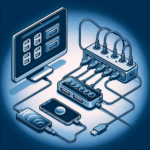In the era of digital information, external hard drives are an essential part of our storage solutions. Whether you are a photographer needing extra space for your high-resolution images or simply someone who likes to keep a backup of important files, having multiple external hard drives can be a lifesaver. However, connecting several of them simultaneously can be a challenge. This is where USB hubs come into play. In this article, we will explore the best USB hubs for connecting multiple external hard drives, helping you to make an informed decision.
| USB Hub Model | Ports | USB Type | Power Supply | Transfer Speed |
|---|---|---|---|---|
| TP-Link UH720 | 7 | USB 3.0 | Powered | 5 Gbps |
| Anker 10-Port USB 3.0 Hub | 10 | USB 3.0 | Powered | 5 Gbps |
| Sabrent 4-Port USB 3.0 Hub | 4 | USB 3.0 | Bus-powered | 5 Gbps |
| ORICO 7 Port USB 3.0 Hub | 7 | USB 3.0 | Powered | 5 Gbps |
| HooToo USB C Hub | 6 | USB-C | Powered | 10 Gbps |
Why Use a USB Hub?
USB hubs are devices that allow you to expand the number of USB ports available on your computer or laptop. This expansion is particularly useful for users with multiple peripherals, such as external hard drives, printers, or other devices that require a USB connection. Here are some reasons to consider using a USB hub:
- Increased Connectivity: USB hubs allow you to connect multiple devices without needing to unplug and replug devices constantly.
- Optimized Functionality: They can help manage power use by providing additional power to devices that may require it.
- Simplified Setup: A USB hub can help keep cords organized, reducing clutter around your workspace.
Key Features to Consider
When selecting the best USB hub for connecting multiple external hard drives, there are several key features to keep in mind:
1. Number of Ports
The number of ports on the USB hub is crucial for connecting multiple external hard drives. Always consider the number of devices you need to connect and choose a hub that meets or exceeds that requirement.
2. USB Type
USB hubs come in various types, including USB 2.0, USB 3.0, and USB-C. USB 3.0 offers significantly faster data transfer speeds than USB 2.0, making it a preferable choice for external hard drives that may have large files.
3. Power Supply
Powered hubs can provide additional power to connected devices, ensuring that they work efficiently. This is especially important for hard drives that can consume more power than what a standard bus-powered hub can provide.
4. Data Transfer Speed
Data transfer speed is vital for users who frequently transfer large files to and from their external hard drives. USB 3.0 hubs typically offer speeds up to 5 Gbps, while USB 3.1 or USB-C can reach up to 10 Gbps.
Recommendations
Now that we have covered various USB hubs in the market, here are some of the best options currently available:
1. TP-Link UH720
The TP-Link UH720 offers 7 USB 3.0 ports, providing enough connectivity for multiple external hard drives. With a powered supply, this hub ensures that all devices receive adequate power and operates at a high transfer speed of up to 5 Gbps, making it a solid choice for performance-driven users.
2. Anker 10-Port USB 3.0 Hub
Anker is known for producing reliable and high-quality tech accessories, and their 10-port USB hub is no exception. This powered hub supports up to 10 devices and delivers a fast transfer rate of 5 Gbps, making it ideal for users needing substantial connectivity.
3. Sabrent 4-Port USB 3.0 Hub
If you’re looking for something compact yet efficient, the Sabrent 4-Port USB 3.0 Hub may be the perfect fit. Though it has fewer ports than others, it’s bus-powered and very portable, making it an excellent option for users on the go.
4. ORICO 7-Port USB 3.0 Hub
This hub is a great option for users looking for a balance between the number of ports and performance. With 7 ports and a powered supply, it efficiently supports multiple external hard drives while maintaining optimal performance.
5. HooToo USB C Hub
For users with USB-C devices, the HooToo USB C Hub is an excellent choice. Providing 6 ports with a transfer speed of up to 10 Gbps, it is perfect for modern external hard drives and works seamlessly with MacBook and other devices featuring USB-C ports.
How to Set Up a USB Hub
Setting up a USB hub is a relatively straightforward process. Here’s a quick guide to help you get started:
Step 1: Choose the Right Location
Find an appropriate location near your computer for easy access to the hub. It should also be close to a power outlet if you are using a powered hub.
Step 2: Connect the Hub
Plug the hub into a USB port on your computer. If it’s a powered hub, also connect the power adapter to an outlet.
Step 3: Connect Devices
Once the hub is set up, you can connect your external hard drives to the available USB ports. Make sure you hear a notification sound to confirm that each drive is recognized by your computer.
Step 4: Organize Cables
Use cable ties or organizers to keep your workspace tidy, ensuring that you have easy access to each device as needed.
Conclusion
When it comes to finding the best USB hub for connecting multiple external hard drives, consider the number of ports, USB type, power supply, and data transfer speed. Options like the TP-Link UH720 and Anker 10-Port USB 3.0 Hub offer robust solutions for power users, while more compact options like the Sabrent 4-Port Hub ensure mobility for users on the go. In conclusion, make an informed decision based on your specific needs, and enjoy the convenience of connecting all your devices seamlessly.


